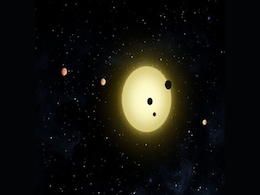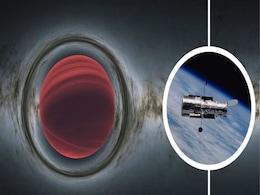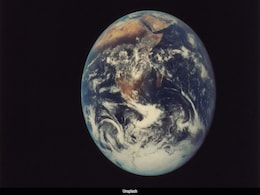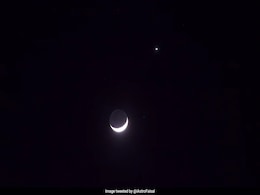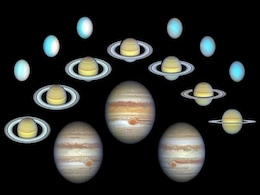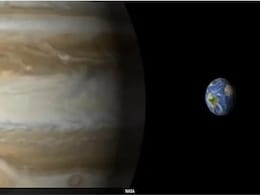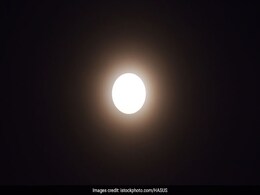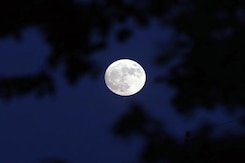Bright Planet
- All
- News
- Videos
- Web Stories
-

Exoplanets Explained: How Astronomers Find Worlds Orbiting Stars Beyond the Sun
- Monday September 8, 2025
- Written by Gadgets 360 Staff
Exoplanets are planets orbiting stars outside our solar system, hidden by stellar glare and detected indirectly. Astronomers identify them by tracking star wobbles or dips in brightness during planetary transits. NASA’s Kepler mission revealed thousands, with TESS now expanding the search. These discoveries confirm that planetary systems are abun...
-
 www.gadgets360.com
www.gadgets360.com
-

New Rogue Planet Discovered in Hubble Data Using Einstein’s Gravity Theory
- Friday August 1, 2025
- Written by Gadgets 360 Staff
Astronomers discovered a rogue planet hidden in Hubble’s archival data using gravitational microlensing based on Einstein’s theory. The event, OGLE-2023-BLG-0524, lasted just eight hours and lacked signs of a host star, suggesting the planet might be truly free-floating.
-
 www.gadgets360.com
www.gadgets360.com
-

Quantum Tech Could Finally Let Astronomers Snap Direct Images of Earth-Like Exoplanets
- Tuesday May 27, 2025
- Written by Gadgets 360 Staff
Astronomers are harnessing quantum mechanics to build a coronagraph that could directly image Earth-like exoplanets previously obscured by stellar glare. By sorting light waves at the photon level, the device bypasses traditional diffraction limits, revealing faint planetary signals. This breakthrough may redefine how scientists explore distant wor...
-
 www.gadgets360.com
www.gadgets360.com
-

Scientists Predict Exact Date Life On Earth Will End: Study
- Tuesday May 13, 2025
- Science | Edited by Nikhil Pandey
A supercomputer simulation predicts that life on Earth will end in 1 billion years due to the depletion of oxygen caused by the Sun's increasing heat and brightness, ultimately rendering the planet uninhabitable.
-
 www.ndtv.com
www.ndtv.com
-

JWST Unveils HH 30’s Protoplanetary Disk, Showing Dust Grains and Jets
- Monday February 10, 2025
- Written by Gadgets 360 Staff
The James Webb Space Telescope has captured an extraordinary image of HH 30, a protoplanetary disk in the Taurus constellation. The dense dust disk conceals the central star, while bright jets extend outward, interacting with surrounding gas. Microscopic dust grains within the disk have been identified, playing a crucial role in planetary formation...
-
 www.gadgets360.com
www.gadgets360.com
-

February 2025 Planet Parade: How to See Five Planets Align in the Sky
- Wednesday February 5, 2025
- Written by Gadgets 360 Staff
A rare celestial event will unfold in February 2025, with five bright planets—Venus, Jupiter, Mars, Mercury, and Saturn—visible in the evening sky. The highlight occurs on February 24, when Mercury and Saturn appear closest. Uranus and Neptune can also be observed with telescopes. Best viewing conditions require a clear west-southwest horizon a...
-
 www.gadgets360.com
www.gadgets360.com
-

Stargazers Treated To Stunning Celestial Scene As Venus Appears Beside Crescent Moon. See Pics
- Sunday January 5, 2025
- Science | Edited by Ritu Singh
On Friday night, the planet was visible to the naked eye in areas with clear skies and minimal light pollution.
-
 www.ndtv.com
www.ndtv.com
-

Hubble Telescope Documents 10 Years of Dramatic Changes on Outer Planets
- Friday December 13, 2024
- Written by Gadgets 360 Staff
NASA’s Hubble Telescope has tracked atmospheric and seasonal changes on Jupiter, Saturn, Uranus, and Neptune over ten years. Key findings include shifts in Jupiter’s Great Red Spot, Saturn’s seasonal phenomena, Uranus’ polar brightness, and Neptune’s storm activity. These insights, part of NASA’s Outer Planet Atmospheres Legacy (OPAL) p...
-
 www.gadgets360.com
www.gadgets360.com
-

Earth Aligns Between Sun And Jupiter For Spectacular December 7 Event
- Thursday December 5, 2024
- Science | Edited by Nikhil Pandey
On December 7, Earth will align between the Sun and Jupiter, creating a rare astronomical event known as Jupiters opposition.
-
 www.ndtv.com
www.ndtv.com
-

November Night Sky 2024: Check Out the Brightest Planets and How to Watch Them?
- Monday November 4, 2024
- Written by Gadgets 360 Staff
November's night sky features a spectacular lineup of planets, including Venus, which becomes increasingly prominent in the west. Mars glows brightly as it approaches Earth, while Jupiter rises in the east, captivating observers with its brilliance. Saturn, with its magnificent rings, is also visible high in the southern sky. This month presents id...
-
 www.gadgets360.com
www.gadgets360.com
-

Why Earth Has Only 1 Moon While Other Planets Have Hundreds
- Tuesday June 25, 2024
- Science | Nicole Granucci, The Conversation
On Earth, you can look up at night and see the Moon shining bright from hundreds of thousands of miles away. But if you went to Venus, that wouldnt be the case.
-
 www.ndtv.com
www.ndtv.com
-

Meteors, Supermoons, A Comet And More: Your Guide To The Sky In 2024
- Wednesday January 3, 2024
- Science | The Conversation
What exciting events will we see in the southern sky in 2024? Meteor showers, Saturn covered by the Moon, close approaches of bright planets to each other, supermoons and, if were lucky, a comet visible to the naked eye.
-
 www.ndtv.com
www.ndtv.com
-

New Method to Discover Exoplanets Orbiting Violent Dead Stars Suggested by Researchers
- Monday July 25, 2022
- Edited by Gadgets 360 Newsdesk
Scientists may soon have a new way to detect planets that are orbiting Cataclysmic Variables (CVs), also known as violent stars. One star drawing material from the other, due to the lack of distance, thereby dimming the second star. The researchers measured the changes in the brightness of four CVs — LU Camelopardalis, QZ Serpentis, V1007 Hercul...
-
 www.gadgets360.com
www.gadgets360.com
-

NASA Skywatching Tips: Pay Attention to the Night Sky This September, Interesting Things Are Happening
- Friday September 3, 2021
- Edited by Gadgets 360 Newsdesk
NASA has shared skywatching tips in its latest Instagram post that can guide space enthusiasts to the noteworthy sights in the night sky through September.
-
 www.gadgets360.com
www.gadgets360.com
-

Exoplanets Explained: How Astronomers Find Worlds Orbiting Stars Beyond the Sun
- Monday September 8, 2025
- Written by Gadgets 360 Staff
Exoplanets are planets orbiting stars outside our solar system, hidden by stellar glare and detected indirectly. Astronomers identify them by tracking star wobbles or dips in brightness during planetary transits. NASA’s Kepler mission revealed thousands, with TESS now expanding the search. These discoveries confirm that planetary systems are abun...
-
 www.gadgets360.com
www.gadgets360.com
-

New Rogue Planet Discovered in Hubble Data Using Einstein’s Gravity Theory
- Friday August 1, 2025
- Written by Gadgets 360 Staff
Astronomers discovered a rogue planet hidden in Hubble’s archival data using gravitational microlensing based on Einstein’s theory. The event, OGLE-2023-BLG-0524, lasted just eight hours and lacked signs of a host star, suggesting the planet might be truly free-floating.
-
 www.gadgets360.com
www.gadgets360.com
-

Quantum Tech Could Finally Let Astronomers Snap Direct Images of Earth-Like Exoplanets
- Tuesday May 27, 2025
- Written by Gadgets 360 Staff
Astronomers are harnessing quantum mechanics to build a coronagraph that could directly image Earth-like exoplanets previously obscured by stellar glare. By sorting light waves at the photon level, the device bypasses traditional diffraction limits, revealing faint planetary signals. This breakthrough may redefine how scientists explore distant wor...
-
 www.gadgets360.com
www.gadgets360.com
-

Scientists Predict Exact Date Life On Earth Will End: Study
- Tuesday May 13, 2025
- Science | Edited by Nikhil Pandey
A supercomputer simulation predicts that life on Earth will end in 1 billion years due to the depletion of oxygen caused by the Sun's increasing heat and brightness, ultimately rendering the planet uninhabitable.
-
 www.ndtv.com
www.ndtv.com
-

JWST Unveils HH 30’s Protoplanetary Disk, Showing Dust Grains and Jets
- Monday February 10, 2025
- Written by Gadgets 360 Staff
The James Webb Space Telescope has captured an extraordinary image of HH 30, a protoplanetary disk in the Taurus constellation. The dense dust disk conceals the central star, while bright jets extend outward, interacting with surrounding gas. Microscopic dust grains within the disk have been identified, playing a crucial role in planetary formation...
-
 www.gadgets360.com
www.gadgets360.com
-

February 2025 Planet Parade: How to See Five Planets Align in the Sky
- Wednesday February 5, 2025
- Written by Gadgets 360 Staff
A rare celestial event will unfold in February 2025, with five bright planets—Venus, Jupiter, Mars, Mercury, and Saturn—visible in the evening sky. The highlight occurs on February 24, when Mercury and Saturn appear closest. Uranus and Neptune can also be observed with telescopes. Best viewing conditions require a clear west-southwest horizon a...
-
 www.gadgets360.com
www.gadgets360.com
-

Stargazers Treated To Stunning Celestial Scene As Venus Appears Beside Crescent Moon. See Pics
- Sunday January 5, 2025
- Science | Edited by Ritu Singh
On Friday night, the planet was visible to the naked eye in areas with clear skies and minimal light pollution.
-
 www.ndtv.com
www.ndtv.com
-

Hubble Telescope Documents 10 Years of Dramatic Changes on Outer Planets
- Friday December 13, 2024
- Written by Gadgets 360 Staff
NASA’s Hubble Telescope has tracked atmospheric and seasonal changes on Jupiter, Saturn, Uranus, and Neptune over ten years. Key findings include shifts in Jupiter’s Great Red Spot, Saturn’s seasonal phenomena, Uranus’ polar brightness, and Neptune’s storm activity. These insights, part of NASA’s Outer Planet Atmospheres Legacy (OPAL) p...
-
 www.gadgets360.com
www.gadgets360.com
-

Earth Aligns Between Sun And Jupiter For Spectacular December 7 Event
- Thursday December 5, 2024
- Science | Edited by Nikhil Pandey
On December 7, Earth will align between the Sun and Jupiter, creating a rare astronomical event known as Jupiters opposition.
-
 www.ndtv.com
www.ndtv.com
-

November Night Sky 2024: Check Out the Brightest Planets and How to Watch Them?
- Monday November 4, 2024
- Written by Gadgets 360 Staff
November's night sky features a spectacular lineup of planets, including Venus, which becomes increasingly prominent in the west. Mars glows brightly as it approaches Earth, while Jupiter rises in the east, captivating observers with its brilliance. Saturn, with its magnificent rings, is also visible high in the southern sky. This month presents id...
-
 www.gadgets360.com
www.gadgets360.com
-

Why Earth Has Only 1 Moon While Other Planets Have Hundreds
- Tuesday June 25, 2024
- Science | Nicole Granucci, The Conversation
On Earth, you can look up at night and see the Moon shining bright from hundreds of thousands of miles away. But if you went to Venus, that wouldnt be the case.
-
 www.ndtv.com
www.ndtv.com
-

Meteors, Supermoons, A Comet And More: Your Guide To The Sky In 2024
- Wednesday January 3, 2024
- Science | The Conversation
What exciting events will we see in the southern sky in 2024? Meteor showers, Saturn covered by the Moon, close approaches of bright planets to each other, supermoons and, if were lucky, a comet visible to the naked eye.
-
 www.ndtv.com
www.ndtv.com
-

New Method to Discover Exoplanets Orbiting Violent Dead Stars Suggested by Researchers
- Monday July 25, 2022
- Edited by Gadgets 360 Newsdesk
Scientists may soon have a new way to detect planets that are orbiting Cataclysmic Variables (CVs), also known as violent stars. One star drawing material from the other, due to the lack of distance, thereby dimming the second star. The researchers measured the changes in the brightness of four CVs — LU Camelopardalis, QZ Serpentis, V1007 Hercul...
-
 www.gadgets360.com
www.gadgets360.com
-

NASA Skywatching Tips: Pay Attention to the Night Sky This September, Interesting Things Are Happening
- Friday September 3, 2021
- Edited by Gadgets 360 Newsdesk
NASA has shared skywatching tips in its latest Instagram post that can guide space enthusiasts to the noteworthy sights in the night sky through September.
-
 www.gadgets360.com
www.gadgets360.com

